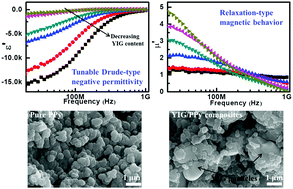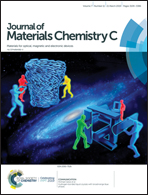Tunable negative permittivity and magnetic performance of yttrium iron garnet/polypyrrole metacomposites at the RF frequency
Abstract
Polypyrrole (PPy) composites incorporating yttrium iron garnet (YIG) particles were prepared by an in situ oxidative polymerization method. The effects of YIG particle loading level on the radio-frequency (RF) electromagnetic properties of the YIG/PPy composites were systematically investigated. A negative permittivity behaviour combined with metal-like conduction was observed in the PPy composites, which was due to the low-frequency plasmonic state of free electrons in the formed conducting PPy networks. The Drude model was used to give a good description of the dielectric response. After increasing the YIG loading, the plasma frequency, at which the real part of permittivity changed from negative to positive, shifted to a lower frequency, and the magnitude (absolute value) of negative permittivity also became smaller. In addition, the permeability of the composites showed a relaxation-type frequency dispersion, which was attributed to the combined effect of the magnetic resonance of YIG particles and diamagnetic response of PPy conducting networks. This work can pave the way for exploiting the regulation mechanism of negative permittivity, benefiting the practical applications of polymer metamaterials.

- This article is part of the themed collection: 2019 Journal of Materials Chemistry C Most Popular Articles


 Please wait while we load your content...
Please wait while we load your content...